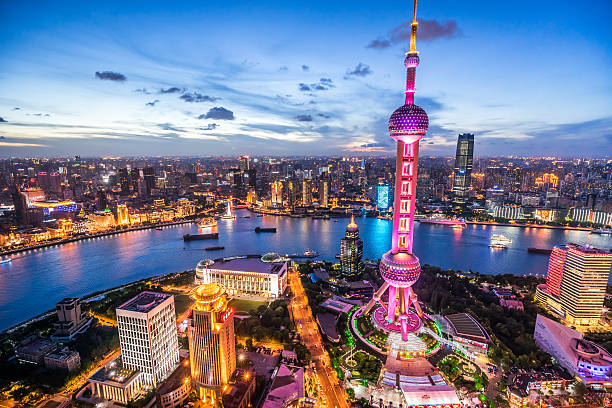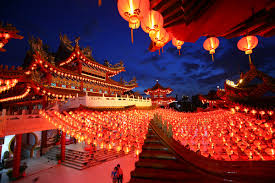When the name “China” is mentioned, images of Shanghai’s skyscrapers, crowded markets, and the Great Wall often come to mind. But beneath this familiar surface lies an “other China” waiting to be discovered. It is a China of pristine nature, of towering mountains that embrace the clouds, and tranquil rivers flowing through surreal landscapes. It is also a China of rich cultural diversity, where dozens of ethnic groups coexist with their own unique dress, traditions, and cuisines. This article is an invitation to leave the familiar tourist path and delve into the heart of this vast country to explore its natural and cultural treasures untouched by the hand of modernity.
Breathtaking Natural Wonders
China is not just cities; it is a unique natural canvas painted by rivers, mountains, and forests over millions of years.
Guangxi (Guilin) Mountains: In southern China lies Guangxi province, known for its fantastical landscapes. The “Li” River, which flows between the cities of Guilin and Yangshuo, is known as one of the most beautiful rivers in the world. Here, towering karst mountains rise from green rice fields, forming landscapes that resemble traditional Chinese paintings. Tourists can take a boat ride to navigate the river and contemplate the enchanting beauty of these unique geological formations, which have been a source of inspiration for poets and artists for centuries. It is a meditative experience, where the tranquility of the river blends with the grandeur of the surrounding nature.
Zhangjiajie Forests: In Hunan province, there is the “Zhangjiajie” National Forest Park, famous for being the inspiration for the mountains in the science fiction movie “Avatar.” Here, thousands of sandstone pillars rise from the ground, surrounded by mist and clouds, creating a surreal landscape as if you were in another world. Visitors can walk on the glass bridges suspended between the mountains or take a cable car to see these pillars from above. It is a thrilling and amazing experience that proves that nature is capable of creating art that surpasses human imagination.
Huangshan (Yellow Mountains): In Anhui province, the Yellow Mountains are located, considered among the most beautiful and famous mountains in China. The “Yellow Mountains” were named after the “Yellow Emperor,” who is considered the great ancestor of the Chinese nation. These mountains are famous for their unique pine trees, strange rock formations, and the clouds that cover their peaks. Watching the sunrise and sunset from the top of these mountains is one of the most beautiful sights a person can see, as the sky is colored with magical hues, and a sea of clouds appears beneath your feet.
The Silk Road and Timeless Cultures
In western China, regions that reflect a unique cultural and civilizational diversity are located, extending along the legendary Silk Road.
A Journey on the Silk Road: Ancient cities in northwestern China, such as “Kashgar” and “Dunhuang,” were key stops on the historic Silk Road. Visiting these cities is a journey through time, where tourists can explore ancient Buddhist caves, see archaeological manuscripts, and feel the spirit of ancient trade that connected East and West. These regions offer a completely different perspective on China, where Chinese culture blends with Islamic, Turkic, and Mongolian cultures, creating a rich and unique civilizational tapestry.
Yunnan Province: Yunnan province in southwestern China is known as the “Kingdom of Cultural Diversity.” Here, more than 25 ethnic minorities live, each with its own language, clothing, and special traditions. Visitors can visit villages like “Lijiang” and “Dali,” which are characterized by unique architectural styles, and watch the celebrations of different nationalities, enjoying their peaceful and simple lifestyle. It is an opportunity to get to know another side of China that is not seen in the major cities.
The Authentic Chinese Taste
The true Chinese experience lies in tasting its food, which reflects its geography and diverse cultures.
Regional Cuisine: Instead of Beijing duck or Cantonese dishes, visitors can discover completely different flavors. In Yunnan province, you can try spicy and refreshing dishes that rely on mushrooms and raw meat. In the regions that were on the Silk Road, you can taste dishes that are influenced by Turkish and Central Asian cuisines, such as “kebabs” and hand-pulled “noodles.” The food experience in small villages and towns is a way to immerse yourself in the local culture and understand the subtle differences between regions.
Chinese Tea: Tea is an integral part of Chinese culture. In Yunnan province, which is the home of the famous “Pu’er” tea, you can visit tea plantations, learn about the production process, and taste different types of tea. Drinking tea is not just a habit; it is a ritual with its own philosophy, teaching patience, tranquility, and appreciation for the moment.
Conclusion
In conclusion, China is not only about modern cities and imperial palaces. It is also a treasure trove of pristine nature, rich cultural diversity, and authentic regional cuisines. Traveling to “the other China” is an experience for the soul, where you can climb fantastical mountains, get to know different nationalities, and taste flavors you never knew existed. It is an invitation to consider that the true greatness of a country lies not only in its buildings, but in its nature, the diversity of its people, and the stories told by every part of its land.








